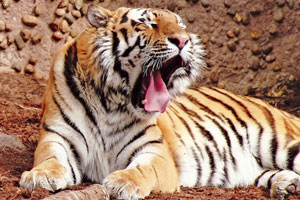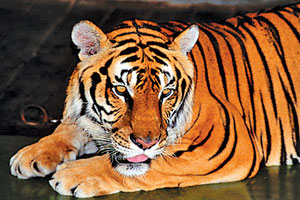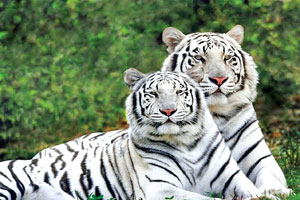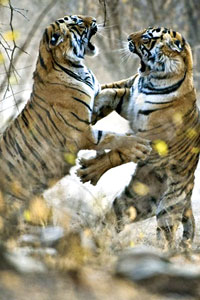|
Nature trail
Bengal tigers:
Powerful predators
The majestic subspecies of one of the five big cats, the Bengal tiger
was in the limelight a few weeks ago, due to the drama surrounding the
struggle by Dehiwela zoo officials to keep alive a new born cub which
was being rejected by its mother who gave birth to it on October 22.
Everyone was broken-hearted to learn that the cute little nameless cub
did not survive. If it had lived, it would surely have helped bolster
the dwindling population of its kind, even in a small way.
Tigers, just as much as leopards are awesome animals in their
vibrantly hued, striped fur coats. And, among the many tiger subspecies,
the Bengal tiger is perhaps the most striking with its flame coloured
fur which immediately captures your attention, if you happen to see one
in a zoo. Of course, in its natural habitat, the Bengal tiger blends
well with the environment and is not so conspicuous. Perhaps,the poet
William Blake was inspired by the Bengal tiger when he wrote the famous
poem 'Tiger', which goes thus.
Tiger! tiger! burning bright
In the forests of the night,
What immortal hand or eye
Could frame thy feared symmetry?
 |
|

Golden tabby. |
|

The white variation. |
A powerful predator, the Bengal tiger (Panthera tigris tigris) or
Royal Bengal tiger is the largest of the five tiger subspecies and the
most common. It is native to India, Bangladesh, Nepal and Bhutan. This
striking big cat has a striped fur coat; dark brown to black stripes on
a yellow to amber or flame orange background. It is known as the Golden
tabby while the variation or a mutation of this tiger species, the white
Bengal tiger, has a coat of white with either dark brown, reddish brown
or black stripes. Some are entirely white. However, the white tigers are
not very common in the wilds. The Bengal tiger's belly area is white and
so is its tail, which has black rings.
The total body length of a male tiger, including its tail is 270-310
cm. Females are smaller, about 240-265 cm in length. The tail alone
measures about 110 cm. A Bengal tiger weighs 235 kg but the tigress is
only about 140 kg in weight. It is believed that Bengal tigers are on
average larger than Siberian tigers.
Bengal tigers, unlike lions, do not live in prides. They are
generally solitary animals, however they have been spotted hunting in
packs sometimes. As tigers are totally carnivorous creatures they prefer
to hunt large prey such as sambur, and water buffalo. Wild boar, hog,
deer, muntajac, and gray langur are also hunted by them. Some of the
small prey include hares, peafowls and porcupines. If they encroach
human settlements, they attack domestic livestock.
The powerful predators which are good swimmers and climbers are known
to attack other predatory animals such as leopards, wolves,jackals,
foxes, Asiatic bears, sloth bears and crocodiles too, even though they
are not strictly a part of their diet.

The Bengal tiger uses stealthy hunting techniques and approaches its
prey from the side or behind. It is quick to disappear or melt into the
wilderness background and become invisible when spotted. But generally
it stalks the prey at a close distance, as possible. It is known to leap
more than 30 ft (9 m) in a single bound when the need arises. It brings
down a victim in a flying tackle, forcing its canine teeth into the
spine or throat. Bengal tigers are known to have the largest canine
teeth among all felids. They are about four inches long.
You may have heard of these tigers attacking humans occasionally.
According to experts, tigers generally became man eaters when they grow
old and cannot hunt any longer. However, it is not the only reasons.
When there is an imbalance in the food chain or when a young tiger has
injured its teeth or paws and finds it difficult to tear its prey, then
the tiger decides to hunt human prey.
Bengal tigers are highly protected today because of the fast
dwindling population. The population in the Indian subcontinent
according to a survey done this year is estimated to be less than 2,500.
of these, about 1,165 - 1,657 are said to be in India, 200-419 in
Bangladesh 100-194 in Nepal and another 67-81 in Bhutan.
One of the major threats to their existence is habitat losses and the
extremely large-scale poaching. The illegal trade in poached body parts
and skin, in the Indian subcontinent between India, Nepal and China is
considered a major threat.
For at least a thousand years, tiger bones have been an ingredient in
traditional medicines which are used as muscle strengtheners, treatment
for rheumatism and other body aches and pains.
The Indian Wildlife Protection Act of 1972 enables government
agencies to take strict measures to ensure the protection and
conservation of these beautiful and powerful cats.
Various conservation projects have been launched by India,
establishing special national parts and Save the Tiger Funds to protect
the Bengal tiger which is a national icon. It has been India's national
symbol since about the 25th century BCE.
Cubs and mums
The birth of a Bengal tiger cub whether in the wilds or in captivity
is certainly a significant event as these majestic cats are faced with
extinction today.
Many births have been recorded of these powerful animals in
captivity, in zoos. The recent birth that took place at the Dehiwela zoo
captured the attention of many. However, as the mother tigress rejected
the cute cub (pictured here) and refused to feed it, the cub did not
survive, despite all the efforts taken by the authorities to hand rear
it.
It is said that sometimes animals in captivity refuse to care for
their young after giving birth.
Remember the polar bear cub named Knut born at a German zoo which
became world famous when its mother rejected it and zoo officials
decided to hand rear it?
In the wilds, however, mothers rarely abandon their new borns. A
Bengal tigress, generally gives birth to its first cub when it's three
or four years old, after a gestation (pregnancy period) of about 104-106
days. The litter of cubs which can number between 2-5 or 6 cubs,is born
in a shelter in the tall grass, thick bush or in caves. Newborn cubs
weigh around 780-1600 g (2 lbs) and have a coat which is thick and
wooly. The coat is shed when they are about three to five months old.
They are blind at birth and even their ears are closed. Their milk
teeth start to erupt only after two or three weeks and are replaced by
permanent teeth when they are about two months old.
Tiger cubs need to be nursed by their mums for 3-6 months but begin
to eat small amounts of solid food at about two months.
|

The unfortunate cub which died at the Dehiwala Zoo. |
At this age they trail behind their mothers on her hunting
expeditions.
By the time they reach five months, they start to take part in
hunting. Both male and females become independent of their mother, when
they are about 18 months old.

At this point, the cubs have to establish their own territory. Young
males generally move away from their mother's territory than young
females.
Male tigers are fiercely protective of their territory and defend it
by engaging in serious fights. Females are less territorial and may even
share its territory with another female. A male's territory is much
larger than that of a female's.
************
Fast facts
* India hosts about two thirds of the Bengal tiger population.
* As of June 2009, tigers are found in 37 tiger reserves spread
across 17 Indian states.
* The Chitwan - Parsa - Valmiki Tiger Conservation Unit in Nepal is
said to be the best in the
world. The only other conservation project to rival it is the Western
Ghats forest complex in
western South India, covering an extent of 14,400 square miles,
stretching across several
highly protected areas.
* In the past, Indian census on wild tigers were carried out using
the identification of individ
ual footprints known as 'pug marks'. Today modern camera trap
counting methods are used.
* Indian zoos have been breeding tigers since 1880, the first
breeding success was recorded at
Alipote zoo in Kolkata.
Facts and pix : Internet |

